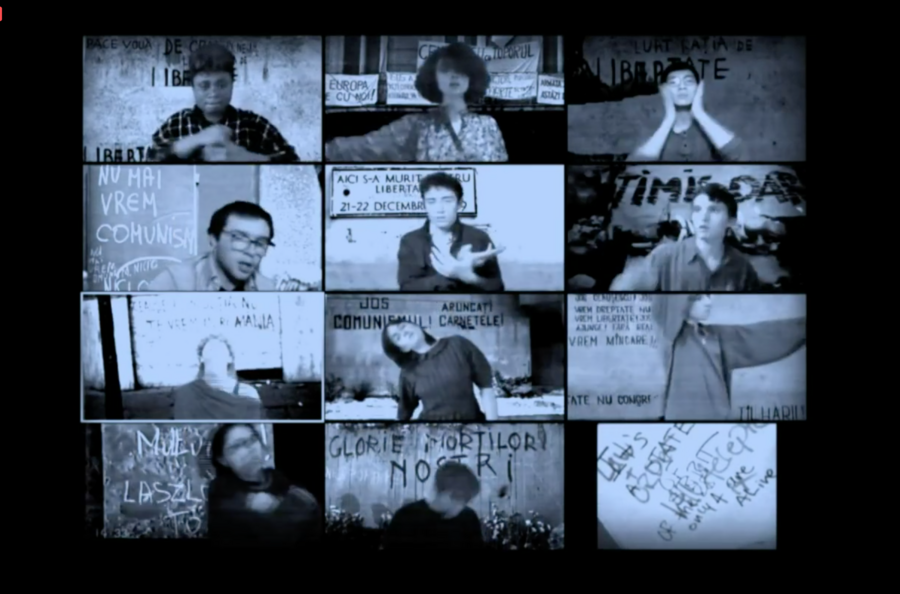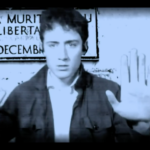“Clap before you say your line.”
When director Ashley Tata and the cast of the Bard College Theater & Performance Program’s production of Caryl Churchill’s Mad Forest first began rehearsing on Zoom, they were held to the conventional functions of the platform—i.e., the way Zoom changes who the audience views based on who speaks, so that Tata’s instruction to clap allowed the camera focus to switch manually, essentially jailbreaking the system.
It wasn’t supposed to go this way. Mad Forest was a few weeks into table reads and initial onstage blocking when COVID-19 closures forced the Fisher Center at Bard to reconceive its spring production for online. Once Zoom rehearsals began, the Mad Forest team set about adapting and adjusting their production, including its design elements, as well as altering the platform itself to create one virtual performance on April 10. But when Jeffrey Horowitz, founding artistic director of New York City’s Theatre for a New Audience, saw that performance, he was inspired to ask the Bard College Fisher Center artistic director Gideon Lester to collaborate and produce the show virtually again, streaming the production live for free on May 22, 24, and 27.
Back when rehearsals were first cancelled, Tata joked that “we could still rehearse on Google Hangout.” She had hoped to use video in her production of the play, which covers the 1989 toppling of Romanian dictator Nicolae Ceaușescu. In it Churchill depicts the ways the oppressive regime used television to deter the uprising—and how the revolution used the same technology in turn to bolster public support.
“We were faced with a choice,” said the Fisher Center’s Lester. “I think it’s important to show the students that it is possible to keep going.” Tata agreed and set out to make a virtual production work.
The learning curve to virtual theatre was admittedly steep in many cases. With Zoom defaulting to presenter view, and sound cues determining who is on screen, Tata’s idea of claps (as well as coughing into microphones) was designed to trick the system into featuring certain performers. Then Andy Carluccio, a video programmer and engineer added to the Mad Forest creative team, designed specific Zoom code to create a virtual stage. This back-end feature allows Sean Leo, the show’s video engineer, to switch the Zoom camera with a computer keyboard, using something called the spotlight feature. These behind-the-scenes adjustments essentially allow for real-time camera editing on Zoom.
To determine what should be in each “shot,” Tata and the Mad Forest design team inventoried the structure and lighting of each performer’s room, which ranged from childhood bedrooms to home offices to a sister’s bedroom. The college then sent the actors green screens, lighting equipment, Bluetooth earbuds, props, costumes, and in some cases even Ethernet cords to hardwire their internet connections.
“In order to get the effect of the cast being in the room together, and because we can have close-ups now, some people need duplicate props,” Tata explained. “Wine bottle labels, money—everything has to be identical.”
Maintaining all these props and equipment now falls completely on each individual actor. There are no dressers to maintain their costumes, prop managers or stage managers to make sure their Bluetooth headphones are charged or wine glasses are set. They even received command hooks to hang their own green screens.
Lighting designer Abigail Hoke-Brady also sent the performers different clip lights, with some more focused, while others have wider bulbs, depending on the natural light in each space. Some packages even included gels, dimmers, and extension cords.
Afsoon Pajoufar, the set designer, originally planned to use virtual renderings of the stage design as a Zoom background, but ended up creating virtual backdrops to use against the green screens. The production wound up using more than 125 custom-designed Zoom backgrounds for virtual settings.
“It’s this hybrid theatre-film,” said Eamonn Farrell, video designer for the production and a director and designer for Anonymous Ensemble. “We’re concerned with eyeline and frame and how performers’ faces fit the camera. We’re creating all the effects live. So all the things that would happen in post-production, like color correction and contrast adjusting, I am using software to do that live.”
When the cast moved into remote locations, Tata reminded the cast which actors were to their right or left so they could keep their eyelines consistent. Most students have hung Post-It notes or signs on their walls off-screen to help them keep the same reference points.
Tata has even addressed the lack of direct audience interaction that comes with a Zoom performance. She manually feeds audience comments through the chat feature to the actors during moments they are off-camera during the play to give them a sense of real-time reactions.
“I think it’s a missed opportunity to say live events just can’t happen until we can be in spaces together,” she said. “I hope that what we’re able to do is ask an audience to consider this type of performance maybe off and on for the next few years. And then I hope that producers are able to consider that as well.”
The Fisher Center presented a single virtual performance of Mad Forest on April 10 as part of its virtual Upstreaming series, with 12 student actors performing from quarantine in remote locations across the country. The cast had originally planned to give five live performances in the Fisher Center theatre, which seats 100 people. The April 10 virtual performance, by contrast, was streamed by 2,400 viewers, according to Tata. One of them was TFANA’s Jeffrey Horowitz.
“It was an immediate reaction,” Horowitz said. “Five minutes after it was over, I emailed Gideon and asked him to collaborate to do this again.”
Horowitz thinks Mad Forest is just the beginning when it comes to innovations within the form. “It’s like what happened to rock ’n’ roll,” he said. “Artists took it to all sorts of places it was never before imagined.”
Victoria Mescall is a Magazine, Newspaper, and Online Journalism graduate student at Syracuse University.





